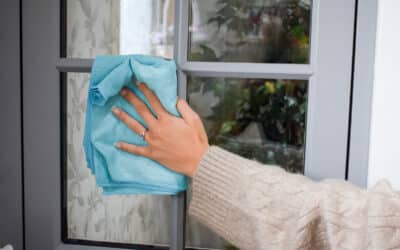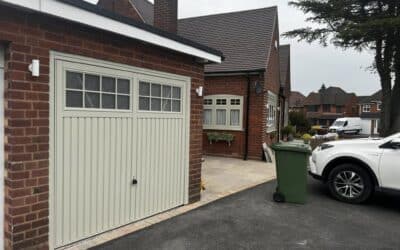UPVC (unplasticised polyvinyl chloride) is a favourite material for home and business owners across the UK and has a range of uses. From windows and doors, to garages and conservatories, UPVC’s low maintenance, high-durability and clean aesthetic makes for a quality property feature.
However, one common issue that homeowners encounter over time is yellowing, which inevitably leads to the questions of ‘why is my UPVC turning yellow?’ and ‘how can I make yellow UPVC white again?’. So, if you’ve noticed your once-pristine white UPVC turning yellow, you’re not alone. In this article, we’ll explore why this happens and how you can remove these yellow stains.
What causes UPVC frames to turn yellow?
There are several factors which contribute to the discolouration of your UPVC windows, doors, garages, conservatories etc. over time, which leads to that unpleasant yellow look. Understanding these causes can help you decide on the best course of action for restoring your property’s appearance.
Common UPVC paint types used by homeowners
There are several types of spray paint accessible to DIY enthusiasts, and a number of popular brands are commonly used by homeowners across the UK. Acrylic-based paints, such as Rust-Oleum and PlastiKote, are often marketed for ease of use and affordability. These can provide decent coverage and a smooth finish on smaller projects but may lack the long-term durability required for exterior applications.
1. UV damage from sunlight
While the UK isn’t known for its sunny skies, the most common culprit behind yellowing UPVC is prolonged exposure to sunlight. While UPVC is designed to resist weathering, over time the effects of constant sunlight can take their toll, leaving your frames with a yellowish tint.
2. Ageing materials
Like most materials, UPVC isn’t immune to ageing. Over the years, the protective coatings applied during manufacturing can degrade, making the material more susceptible to staining and yellowing. If your windows, doors or other UPVC fixtures are more than a decade old, natural wear and tear could be to blame. If your windows, doors or other UPVC fixtures are more than a decade old, natural wear and tear could be to blame.
3. Environmental pollution
External factors such as air pollution, dirt and grime can also play a role in staining your UPVC yellow. Properties located in urban areas or near busy roads are more likely to experience these issues. Over time, pollutants can build up on the surface of UPVC, creating a yellowish or greyish cast.
4. Nicotine staining
You might not think it, but if UPVC is installed in properties where smoking has taken place over the years, especially indoors or in enclosed spaces such as porches or conservatories, the tar and nicotine from cigarette smoke can settle on surfaces and cause discolouration. This staining can be quite stubborn and may require more than just a surface clean.
5. Poor quality UPVC or finishes
Not all UPVC is created equal. Lower quality materials or substandard finishing products may lack the proper UV stabilisers or durable coatings needed to withstand the elements. As a result, these products are far more likely to yellow and degrade prematurely compared to high-grade alternatives. So when you are dealing with the installation or replacement of your UPVC frames and fixtures, be sure to keep an eye out for high-quality brands such as Deceuninck, Duraflex, Eurocell, Profile 22 and more.
6. Cleaning products and chemical exposure
Harsh chemical cleaners, particularly those that contain bleach or solvents, can react negatively with UPVC surfaces. Rather than removing stains, they may actually contribute to discolouration over time by breaking down the protective outer layer.
How to prevent UPVC from turning yellow
Preventing your UPVC from turning yellow requires a proactive approach to care and maintenance. Regular cleaning using mild, non-abrasive detergents will help remove dirt, grime and potential pollutants before they take hold. It’s also important to avoid bleach or solvent-based cleaners which can damage the surface. Applying a UV-protective polish or coating can provide additional resistance against sun damage, which will help preserve that flawless white finish for longer. Additionally, if you’re having new UPVC installed, always opt for high-quality materials from reputable suppliers to ensure long-term performance and colour retention.
You can also consider UPVC spray painting which is an affordable and low-maintenance method of method of refreshing yellowed frames and restoring them to their original appearance. This process involves thorough cleaning, light sanding to create adhesion, and applying specialised UPVC paint designed to withstand outdoor conditions. Professional spray painting can give your windows and doors a fresh, uniform finish while providing additional UV protection to prevent future yellowing. The paint typically lasts 10 – 15 years with proper preparation and application, making it a cost-effective alternative to full replacement.
Conclusion
Yellowing UPVC can be an eyesore, but understanding the causes behind it helps you take the right steps towards restoration and prevention. Whether it’s exposure to sunlight, age, pollution or even poor maintenance practices, there are ways to breathe new life into your UPVC surfaces. With regular care and, if necessary, professional spraying services, you can restore that crisp, clean look to your home’s exterior and keep it looking its best for years to come.



0 Comments